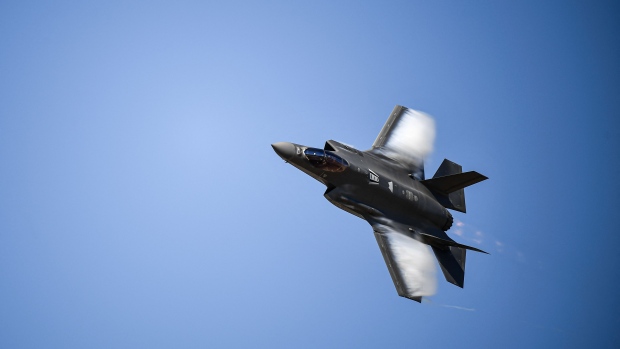Dec 12, 2023
Lockheed F-35’s Upgrade Overrun Risks Topping $1 Billion, Top Lawmaker Says
, Bloomberg News

(Bloomberg) -- A cost overrun to upgrade the cockpit computer on Lockheed Martin Corp.’s F-35 is projected to hit almost $1 billion next year if delivery delays persist, according to the top House lawmaker overseeing the world’s most expensive weapons program.
What started out as a $718 million contract in 2018 to develop a major upgrade for the fighter jet increased last year by $680 million. Now, “regrettably, we acknowledge an additional cost increase of around $225 million,” Representative Rob Wittman, a Virginia Republican who chairs the House Armed Services panel on aircraft, said in a statement to Bloomberg News.
That $905 million overrun will increase by $20 million to $24 million each month if deliveries of planes equipped with the upgrade, known as TR-3, don’t start by next June as the Pentagon hopes, according to Wittman, who is holding a hearing Tuesday on the F-35.
The combat aircraft needs a hardware and software upgrade before it can carry more precise weapons and gather more information on enemy aircraft and air defenses. It will increase processing power 37 times and memory 20 times over the F-35’s current capabilities.
US taxpayers and allied nations that buy the fighter jet will absorb the cost of the entire overrun under terms of the “cost-plus development” contract. But Lockheed, the largest US defense contractor, forfeited $60 million in profit for an earlier overrun and isn’t receiving any profit for the remaining upgrade work, the Pentagon’s F-35 program office said last year.
Earlier: Crucial F-35 Computing Upgrade Sees New Cost Overrun and Delay
Russell Goemaere, spokesman for the program office, said “we agree with Representative Wittman’s comments on the overrun.”
The first deployment of F-35s with the upgrade was to begin last January, and delays have affected squadrons waiting for the changes, Wittman said. The program office now projects those could start next April to June depending on test progress.
Wittman said Lockheed and L3Harris, its major subcontractor on the TR-3 upgrade, “are facing challenges in developing reliable software for the new hardware.”
“Over the past few months, we began testing the next software release that will improve stability, radar and weapons capability,” Lockheed said in a statement. “We also began test flights using TR-3 software on F-35 production jets in Fort Worth, and flight test continues at Edwards Air Force Base and Naval Air Station Patuxent River.”
“As of early December, we have completed more than 160 flights” and “remain focused on expediting hardware delivery from our subcontractors that will be integrated with TR-3,” it said.
(Updates with F-35 program office comment in sixth paragraph)
©2023 Bloomberg L.P.








